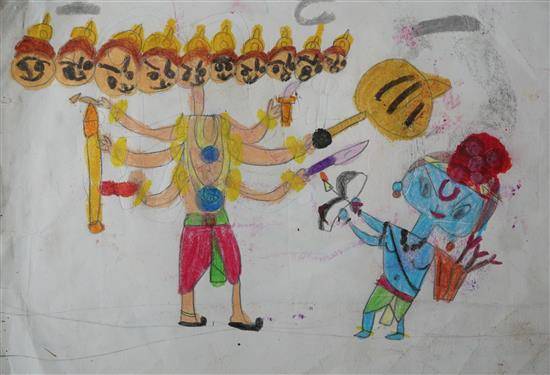Every year, the followers of Vedic culture celebrate two Navratris – Chaitra Navratri and Sharadiya Navratri. Both festivals are equally revered by people but Chaitra Navratri is special because the ninth day attributed to Devi Siddhidatri is the auspicious day when Lord Ramchandra made his descent on earth.
Lord Ramchandra is addressed by various names but is popularly known as Maryada Purushottama or a person of sound character. It is stated in Srimad Bhagwatam (9.10.11) that he himself set the standards for the person’s character by treading on the path of virtue, and righteousness.
Ram Navami or popularly known as Sri Ram Navami is the festival celebrated with great faith and devotion in the pious land of Bharatvarsha. This festival is of great importance for the people of Ayodhya and Chitrakoot.
The history of Ram Navami
It is believed that on the auspicious day of Shukla Paksha Navami, at 12 noon, Lord Ramchandra made his divine appearance along with his three brothers, Lakshmana, Bharat and Shatrughna in Ayodhya (a province in present-day Uttar Pradesh). He appeared in the house of Maharaja Dashratha who was extremely worried about the absence of sons in his dynasty. Hence, he pleaded to his spiritual master, who in turn asked him to pray to Rishyashringa muni.
With the help of his daughter Shanta, he convinced Rishyashringa to perform Putrakameshti yagya. On its completion, Vishnuduta appeared and handed him a bowl of kheer. One half of it was given to Kaushalya, and one fourth to Kaikeyi. Fearing that Sumitra, the third wife would be left behind, both Kaushalya and Kaikeyi gave some portion of their share which resulted in two one-eights.
Significance
This day holds great significance for people who are devout followers of Lord Ramchandra. As per Hari Bhakti Vilasa, it is said that the devotees of Vishnu must fast as fasting can award them with great spiritual boons and can help them elevate their levels of spiritual understanding.
The science behind Ram Navami
The day of Ram Navami falls on the ninth day of Navratri. Generally, it’s a tradition in India to end Navratri celebrations on the night of Ashtami or Navami by cooking some grains and sweets in the house and then offer them as prasada to Devi Durga and feed young boys and girls, termed as Kanjika.
But, as per Ayurveda, it was advised by the ancient seers and sages to keep a fast on the day of Navami and take boiled vegetables as the prasadam so as to keep the body healthy and fit. The reason behind it is because the transition from spring to summer is taxing on the digestive system, especially with the increased levels of mucus or kapha in the body. Sweet items and the grains would only aggravate it.
How Ram Navami is celebrated
As per Agastya Samhita and Rama Archana Chandrika, the detailed procedure has been elaborated. In the northern and central parts of India, people celebrate it on the concluding day of Navratri. The temples are decorated with flowers and the deities are magnanimously dressed and are bejeweled with various ornamental offerings.
People generally observe a fast till sunset and refrain from all sorts of sinful activities like intoxication, lying, cheating etc. and keep themselves absorbed in chants and meditation.
In southern India, a nine-day festival is held in which daily recitation of Valmiki Ramayana is organized (Nav divas Ramayana Parayanam) and on the concluding day, devotees fast till sunset, followed by Abhishekam and Prasadam distribution.
Simple and Household Pooja Samagri
Items needed:
* Pure cow’s ghee: To light a lamp
* Cotton wick and earthen/metal lamp: Offering a lamp signifies illumination of the mental levels for spiritual upliftment
* Fruits: To purify the existence of the body
* Fragrant Flowers: To create a pleasing and calming atmosphere for the puja
* Panchamrita (Ghee, Sugar, Honey, Milk and Curd): To be offered for bathing and taken as prasad which becomes like an elixir for the body
* Gangajal: To disinfect the surroundings from pathogens
* Tulsi leaves: To offer the dearest item to Lord Ramchandra
* Unbroken rice: Signifies unbroken communion between God and devotee
* Bell and incense: To create vibrations that have a positive impact
* Naivedya (cooked items in purity without garlic and onions): Sattvic food having properties that eliminate the wrong desires and promote intellect
* White chandan: Tilak is applied on the forehead to activate the Aagya chakra responsible for patience and faith in the deity.
Household Puja Vidhi:
* The devotee must get up early in the morning, have a bath and put on clean clothes. He should fast the whole day till sunset.
* One must clean the altar table at home with a new clean cloth and spread a new red cloth over the table and put a picture of Sri Rama Darbar.
* One must offer incense sticks, lamp and flowers to Lord Ram and his associates. The items must be offered by encircling them around the deity 7 times.
* After offering the items, one must offer Panchamrita mixed with Gangajal and tulsi leaves to the lord.
* The cooked Naivedya must be offered to the Lord with tulsi leaves and one must keep it safe for the next day.
* The day should be dedicated to thinking, chanting, meditating, hearing, singing and talking about the glories of Lord Ramchandra.
* In the evening, one must perform the similar puja and then, one must break the fast with the Ekadashi prasadam (without grains) after chanting this mantra:
Tava prasada svikarat, krtam yat paranam maya
vratenanena santushta, svasti bhaktim prayaccha me
Shastric Puja Vidhi
The shastric puja Vidhi for Ram Navami includes Shri Kalash Sthapan, Avahan, Swastivachan, Shodashopchar Puja, Sri Ramchandra Padabhisheka, Sri Brihad Vishnu Sahasranama Paath, Sri Ram Darbar Puja, Purnahuti, Homa and Visarjan.
Courtesy : Saumyaa Vardhan
